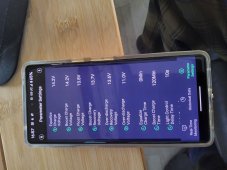Here goes. I've googled the hell out of this. And searched.
My system consists of 4 100 watt hqst panels, a 40 amp hqst mppt controller and a 300 amp hour chins battery with a shunt meter attached. I've tried all kinds of parameters photo is of the current settings.
I'm getting 22.5 volts at 14 amps from my panels on a good day. The controller is only putting out 5 to 6 amps at 14.4 volts with that input. My battery soc can be from 60% to 90% and it's the same situation. By my math, I should be getting about 20 amps at 14.4 volts.
Are my expectations wrong? If not, what should I look at to troubleshoot.
My system consists of 4 100 watt hqst panels, a 40 amp hqst mppt controller and a 300 amp hour chins battery with a shunt meter attached. I've tried all kinds of parameters photo is of the current settings.
I'm getting 22.5 volts at 14 amps from my panels on a good day. The controller is only putting out 5 to 6 amps at 14.4 volts with that input. My battery soc can be from 60% to 90% and it's the same situation. By my math, I should be getting about 20 amps at 14.4 volts.
Are my expectations wrong? If not, what should I look at to troubleshoot.



